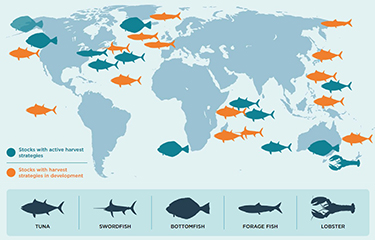Numerous NGOs have been pushing for regional fisheries management organizations (RFMOs) to adopt harvest strategies as a means of effectively managing seafood stocks, but even their fiercest advocates admit the path toward their adoption isn’t easy.
A harvest strategy is a method in which RFMOs and other fisheries managers develop predetermined actions that trigger when stock assessments, catch data, and return on effort – among other metrics – reach certain thresholds. In recent years, RFMOs have been adopting them because they help eliminate the political wrangling that would otherwise dilute scientific advice.
In 2022, the Ocean Foundation and the United Nations Food and Agriculture Organization launched HarvestStrategies.org to provide information on current developments and implementations; recently, an interactive map has been posted on the site showing which RFMOs have thus far adopted harvest strategies.
When an RFMO implements a harvest strategy, it establishes a management procedure called a harvest control rule, which allows it to take action automatically, avoiding egotiations between RFMO member-states that can often stalemate, such as what transpired when some members of the Indian Ocean Tuna Commission attempted to ban the use of drifting fish-aggregating devices (dFADs).
“Members found it difficult to move forward without fully understanding the implications of the harvest strategies,” Pacific Island Forum Fisheries Agency (FFA) Director of Fisheries Management Ludwig Kumoru said during a 19 October HarvestStrategies.org webinar moderated by The Pew Charitable Trusts.
Kumoru said WCPFC decision-making is complicated because most fishing occurs within the exclusive economic zones of small island developing states. Small states are often heavily dependent on fisheries for as much as half of all national income and are cautious about locking into a harvest strategy that cannot be easily changed in the future. At the same time, small island states lack the technical capacity to understand the details of harvest strategy design – a topic in which the FFA tries to help. The FFA also aims to achieve a consensus when negotiating with distant-water fishing nations.
With the experience of the skipjack tuna harvest strategy behind them, Kumoru said Pacific states are more likely to embrace harvest strategies for other species in the future. He predicted the next one adopted will be ...
Image courtesy of harveststrategies.org








